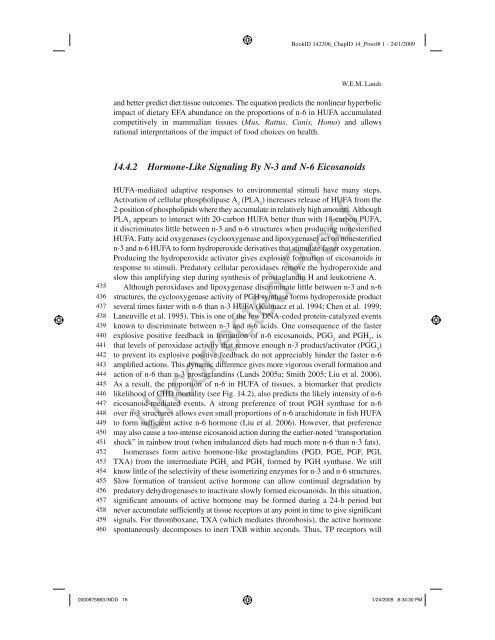Human Life: Caught in the Food Web - NUT Nutrition Software
Human Life: Caught in the Food Web - NUT Nutrition Software
Human Life: Caught in the Food Web - NUT Nutrition Software
Create successful ePaper yourself
Turn your PDF publications into a flip-book with our unique Google optimized e-Paper software.
BookID 142306_ChapID 14_Proof# 1 - 24/1/2009<br />
16 W.E.M. Lands<br />
and better predict diet:tissue outcomes. The equation predicts <strong>the</strong> nonl<strong>in</strong>ear hyperbolic<br />
impact of dietary EFA abundance on <strong>the</strong> proportions of n-6 <strong>in</strong> HUFA accumulated<br />
competitively <strong>in</strong> mammalian tissues ( Mus, Rattus, Canis, Homo ) and allows<br />
rational <strong>in</strong>terpretations of <strong>the</strong> impact of food choices on health.<br />
14.4.2 Hormone-Like Signal<strong>in</strong>g By N-3 and N-6 Eicosanoids<br />
435<br />
HUFA-mediated adaptive responses to environmental stimuli have many steps.<br />
Activation of cellular phospholipase A (PLA ) <strong>in</strong>creases release of HUFA from <strong>the</strong><br />
2 2<br />
2-position of phospholipids where <strong>the</strong>y accumulate <strong>in</strong> relatively high amounts. Although<br />
PLA appears to <strong>in</strong>teract with 20-carbon HUFA better than with 18-carbon PUFA,<br />
2<br />
it discrim<strong>in</strong>ates little between n-3 and n-6 structures when produc<strong>in</strong>g nonesterified<br />
HUFA. Fatty acid oxygenases (cyclooxygenase and lipoxygenase) act on nonesterified<br />
n-3 and n-6 HUFA to form hydroperoxide derivatives that stimulate faster oxygenation.<br />
Produc<strong>in</strong>g <strong>the</strong> hydroperoxide activator gives explosive formation of eicosanoids <strong>in</strong><br />
response to stimuli. Predatory cellular peroxidases remove <strong>the</strong> hydroperoxide and<br />
slow this amplify<strong>in</strong>g step dur<strong>in</strong>g syn<strong>the</strong>sis of prostagland<strong>in</strong> H and leukotriene A.<br />
Although peroxidases and lipoxygenase discrim<strong>in</strong>ate little between n-3 and n-6<br />
436 structures, <strong>the</strong> cyclooxygenase activity of PGH synthase forms hydroperoxide product<br />
437 several times faster with n-6 than n-3 HUFA (Kulmacz et al. 1994 ; Chen et al. 1999 ;<br />
438 Laneuville et al. 1995) . This is one of <strong>the</strong> few DNA-coded prote<strong>in</strong>-catalyzed events<br />
439 known to discrim<strong>in</strong>ate between n-3 and n-6 acids. One consequence of <strong>the</strong> faster<br />
440<br />
441<br />
442<br />
explosive positive feedback <strong>in</strong> formation of n-6 eicosanoids, PGG and PGH , is<br />
2 2<br />
that levels of peroxidase activity that remove enough n-3 product/activator (PGG ) 3<br />
to prevent its explosive positive feedback do not appreciably h<strong>in</strong>der <strong>the</strong> faster n-6<br />
443 amplified actions. This dynamic difference gives more vigorous overall formation and<br />
444 action of n-6 than n-3 prostagland<strong>in</strong>s (Lands 2005a ; Smith 2005 ; Liu et al. 2006) .<br />
445 As a result, <strong>the</strong> proportion of n-6 <strong>in</strong> HUFA of tissues, a biomarker that predicts<br />
446 likelihood of CHD mortality (see Fig. 14.2 ), also predicts <strong>the</strong> likely <strong>in</strong>tensity of n-6<br />
447 eicosanoid-mediated events. A strong preference of trout PGH synthase for n-6<br />
448 over n-3 structures allows even small proportions of n-6 arachidonate <strong>in</strong> fish HUFA<br />
449 to form sufficient active n-6 hormone (Liu et al. 2006 ). However, that preference<br />
450 may also cause a too-<strong>in</strong>tense eicosanoid action dur<strong>in</strong>g <strong>the</strong> earlier-noted “transportation<br />
451 shock” <strong>in</strong> ra<strong>in</strong>bow trout (when imbalanced diets had much more n-6 than n-3 fats).<br />
452 Isomerases form active hormone-like prostagland<strong>in</strong>s (PGD, PGE, PGF, PGI,<br />
453<br />
454<br />
TXA) from <strong>the</strong> <strong>in</strong>termediate PGH and PGH formed by PGH synthase. We still<br />
2 3<br />
know little of <strong>the</strong> selectivity of <strong>the</strong>se isomeriz<strong>in</strong>g enzymes for n-3 and n-6 structures.<br />
455 Slow formation of transient active hormone can allow cont<strong>in</strong>ual degradation by<br />
456 predatory dehydrogenases to <strong>in</strong>activate slowly formed eicosanoids. In this situation,<br />
457 significant amounts of active hormone may be formed dur<strong>in</strong>g a 24-h period but<br />
458 never accumulate sufficiently at tissue receptors at any po<strong>in</strong>t <strong>in</strong> time to give significant<br />
459 signals. For thromboxane, TXA (which mediates thrombosis), <strong>the</strong> active hormone<br />
460 spontaneously decomposes to <strong>in</strong>ert TXB with<strong>in</strong> seconds. Thus, TP receptors will<br />
0000875883.INDD 16 1/24/2009 8:34:30 PM


